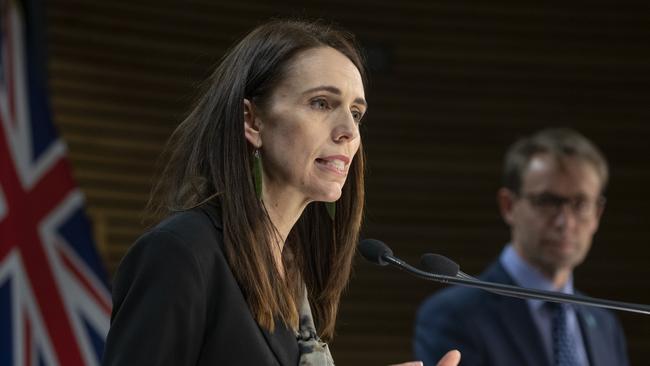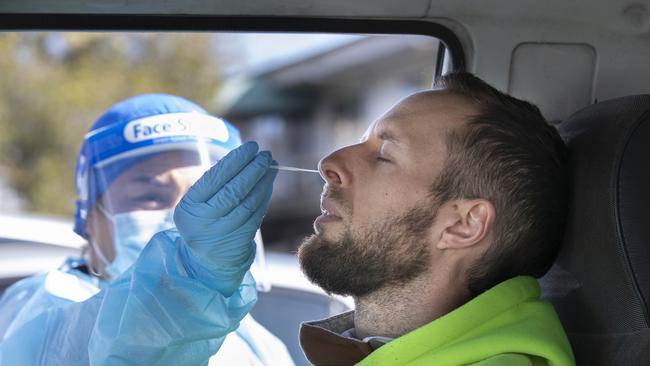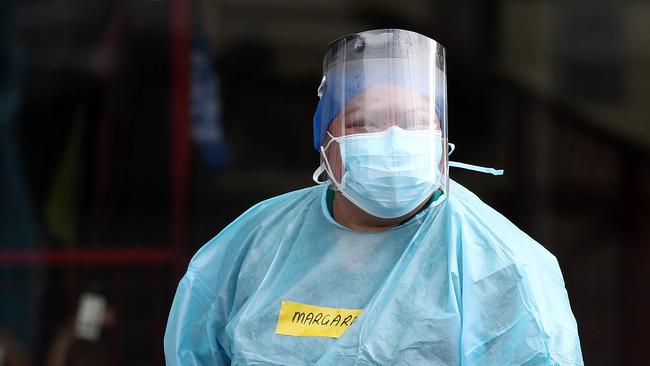Coronavirus: New Zealand records 14 new cases of COVID-19
New Zealand has recorded 13 new COVID cases in Auckland, with the country’s total number of active cases now at 36.
New Zealand has recorded 13 new COVID cases in Auckland, all of whom will go into quarantine.
All of the new cases are linked to the original four confirmed cases from the new outbreak in the city’s south, which was first reported on Tuesday night.
One additional person is in managed isolation - a woman in her 30s who arrived from the Philippines.
New Zealand’s health chief Dr Ashley Bloomfield said the total number of active cases is now 36.
Two of the new cases are children under the age of nine.
It comes after three more staff members at the Americold warehouse centre in Auckland tested positive to COVID-19. The three staffers worked alongside a man who already tested positive.
“It‘s not good. There’s a lot of people awaiting test results, they’ve got families. There’s a lot of anxiety and concern,”Americold managing director Richard Winnall told The New Zealand Herald.
New Zealand’s top health authority has hit out at claims the country is being too soft on people infected with COVID-19.
Director-general of health Ashley Bloomfield dismissed the suggestion the government wasn’t going hard enough on quarantining people who may have come into contact with the virus.
“I don’t think we have been soft on this at all. We don’t round up people in New Zealand,” he told Newstalk ZB. “We round up sheep; we don’t round up people.”
It comes after it was revealed a high school student in Auckland has now tested positive for coronavirus – a person who was a close contact of the original family of whom four members tested positive.
Dr Bloomfield said some of the original family were in a quarantine facility but not all of them.
New Zealand’s Cabinet will decide on the future of the country’s lockdown tomorrow, including how long the new restrictions last, the severity of the new outbreak and whether the source of infection has been found.
“We are getting all our information together so we can get the best possible advice. I feel confident we will have a lot more good information to inform a good decision,” Dr Bloomfield said.
RELATED: How did COVID-19 resurface in New Zealand?

New Zealand’s deputy leader Winston Peters said authorities “won’t know for sure” how the virus reappeared in the country until the medical evidence comes in.
“We don’t know how far it’s spread in the last 24 hours. We don’t know how wide the spread is, whether it’s dispersed outside of Auckland and whether we have a fix on all the cases. It is one of those in-between times. We need to know the research and the evidence and we don’t have it yet,” he told Today.
He said New Zealanders “from the Prime Minister down” are “all annoyed about this”.
“We have to grit our teeth. It is not about the politicians or anyone else. It is about five million New Zealanders. We have to get our team together and that has to be our number one focus.”
‘LOW POSSIBILITY’ VIRUS CAME IN ON FREIGHT
Virus hunters in New Zealand are racing to determine whether the mystery outbreak after 100 days COVID-free could have been freighted into the country in frozen food, or even remain frozen in a cold storage facility for weeks.
One of the family members works in a coolstore that takes imported frozen goods from overseas.
But Dr Bloomfield said it was only a “low possibility” the virus came in on freight.
“We are working flat out to do the contact tracing we need to do and trace back to find out what the source of this infection is,” he said.
Epidemiologist at Melbourne University, Tony Blakely, said it was “bizarre” how the virus had risen again, but he also did not believe it could have come in on freight.
RELATED: Ardern slams virus conspiracy theory

Dr Bloomfield confirmed on Wednesday “environmental testing” of a cold storage facility where the person worked will now be conducted.
“We do know from studies overseas, that actually, the virus can survive in some refrigerated environments for quite some time,” he said.
“We start by looking at all the options and ruling then out, and that’s the position we’re in at the moment.
“In general, the role of surfaces for transmitting the virus has probably been overemphasised in the past.
“There’s much more focus now on transmission in indoor environments, and respiratory droplets and aerosols.”
To date there appears to be no credible evidence of the virus transmitting through food, freight or food packaging.
“I know that the virus re-emerging in our community has caused alarm and the unknown is scary. That causes anxiety for many of us,” Dr Bloomfield said.
“We are working hard to put together the pieces of the puzzle as to how this family got the virus. We are testing all close and casual contacts.”
FROM ‘SUCCESSFUL ELIMINATION’ TO LOCKDOWN
With a population of five million, New Zealand won widespread praise for its effective handling of the coronavirus pandemic after closing its borders on March 19.
The World Health Organisation (WHO) hailed the country as an example to others for having “successfully eliminated community transmission”.
Since the first patient was diagnosed in February there have been 1223 confirmed cases of the virus in New Zealand. Until yesterday, the last case of community transmission was recorded on May 1.
While massive surges broke out in the United States, Brazil, India and Russia, New Zealanders were enjoying a near-normal, pre-coronavirus lifestyle with no social distancing. Spectators were allowed at sports and cultural events.
Other than the border being strictly controlled and all arrivals required to spend 14 days in quarantine, life inside New Zealand had basically resumed as normal.
RELATED: NZ expats blast Ardern

Ms Ardern’s government did maintain the prospect of a second wave remained a possibility, and pushed for all households to keep emergency supply kits, including masks, on hand.
As of midday Wednesday, new rules are in place. Auckland is at stage 3 restrictions, while the rest of the country is at stage 2.
This means people living in Auckland will have to work from home unless they are an essential services worker. Schools will only remain open for students whose parents are essential workers.
Public facilities, bars, restaurants and businesses in Auckland will be forced to close, and gatherings of more than 10 people are prohibited. For the rest of the country, mass gatherings are now limited to 100 people.
Ms Ardern has also urged everyone to wear masks to help prevent the spread of the virus, noting people can fashion their own face covering if needed.
Supermarkets have already moved to immediately restrict the sale of some essential products to ensure demand can be met and prevent stockpiling.


